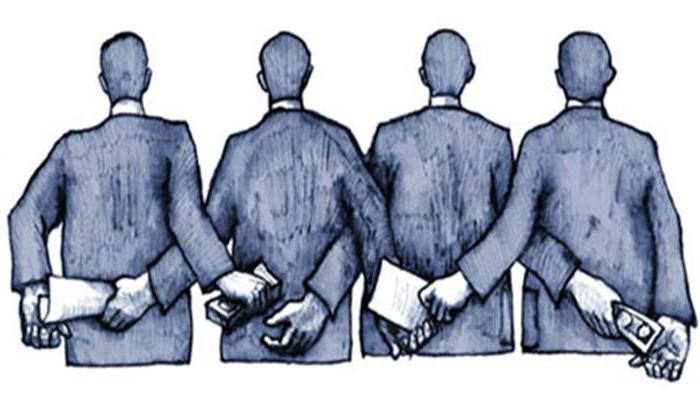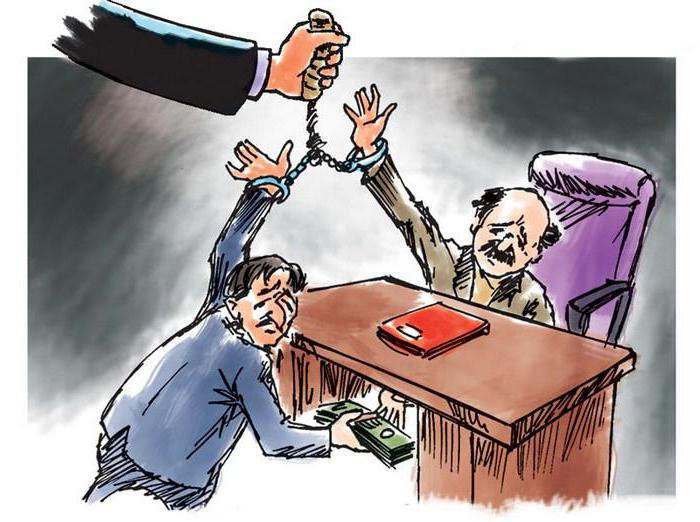Corruptive factors, examples of which will be given in the article, represent certain conditions that create an opportunity for officials to break the law. For quite a long time there were discussions about them in the scientific community. Most often, the discussion was conducted by representatives of the criminal procedure sphere and criminologists. With the adoption of special legislation, legal corruption factors were introduced into regulatory practice. Let's consider them in more detail. 
Corruption
In states with a well-developed legal system, cases of illicit enrichment by government officials are not uncommon. It is called corruption. There are several definitions of it. In Ozhegov’s dictionary, for example, corruption is interpreted as the moral corruption of politicians and officials, which is expressed in illegal enrichment, theft, bribery, and interaction with criminal structures. For countries with an underdeveloped legal system, such a definition can hardly be applied. This is due to the fact that in such states theft of officials is quite legal, using existing gaps in the rules.
Background
It is considered quite common that the head of administration or a member of the government is also an entrepreneur. Formally, in such cases, the business owners are his relatives. If the law does not prohibit, for example, the spouse of an official from being an entrepreneur, then in fact the official provides services to himself. Another example of corruption is arbitrariness in the sphere of power. Its peak in Russia was celebrated in the early 2000s. Bribery also acts as a manifestation of corruption. In the years of the USSR, small presentations to suppliers, sellers and other entities were in the order of things. This was a distinctive feature of the life of Soviet citizens and the work of enterprises. According to experts, the size of small bribes in the USSR was larger than today in Russia. Meanwhile, the overall level of corruption was significantly lower. The versatility and complexity of lawlessness in the bureaucracy is that in fact there are two directions.
Small and large corruption are different phenomena between which there is no close mutual dependence. In the era of Brezhnev, without any offering, it was difficult to get a scarce product. In this regard, procurers worked at almost all enterprises, who bribed officials to obtain certain resources or goods. Even ordinary citizens had to bring small gifts: plumbing for repairs, a doctor - for good treatment, and so on. Moreover, during the years of the USSR, major corruption was practically absent. In modern Russia, the situation is somewhat different. Recently, officials have been stealing large-scale, using their powers, gaps in laws. All this negatively affects the rating of the country. Despite the adoption of anti-corruption legislation, scandals periodically arise in the state related to the arbitrariness of officials. Petty corruption is practically absent in the country today. Currently, there is no need to give bribes to suppliers, store directors, and company employees. Meanwhile, the state has developed a system of corruptogenic factors that contribute to large arbitrariness. 
Normative base
In the Federal Law, the provisions of which regulated the fight against corruption, did not directly indicate conditions conducive to violation of the law. The regulatory act defines special preventive measures. Among them there is an anti-corruption examination. In March 2009, 2 government decrees were approved immediately. The first regulated the rules for the examination of normative acts and other documents to identify provisions that provoke corruption risks. The Second Decree approved the methodology for performing this check. It was in it for the first time that corruptogenic factors were identified.
Characteristic
Corruptive factors act as a consequence of the application of norms that are not consistent with the law. They contribute to the creation of conditions for abuse of authority both in isolated cases and systematically. In essence, their typification indicates that the subjects of rule-making quite often use patterns that pass from one to another. Corruption factors in terms of legal technology can be called defects in acts and regulations in the sense in which the conditions are formed for officials to extract improper benefits. 
Specificity of concepts
In terminology, corruption factors that act as a defect in the norm are distinguished. The Methodology, approved by Decree No. 196, states that they recognize the provisions of projects that may contribute to violations of the law in the application of documents, and may also be the direct basis of abusive practices or create conditions for the legitimacy of acts, provoke or allow them.
Classification
Corruptive factors have a number of distinctive features. First of all, they are exclusively the provisions of regulatory documents and their projects. Their content also has certain specifics. Depending on the orientation, the following types of corruption-generating factors are distinguished:
- Establishing an unreasonably wide scope of authority for an entity applying the rules.
- Providing uncertain requirements for organizations and citizens.
- Establishing the possibility of unreasonable application of existing exceptions to the rules.
- Providing difficult to fulfill requirements for legal entities and citizens.
It must be said that in practice any combination of them is possible. The key condition is that, together or separately, they form corruption risks. 
Contradictions in norms
In accordance with the Law of July 17, 2009, not only provisions in projects, but also in already approved legal acts are corruptogenic factors. In this regard, it is fundamentally important to refer not only to future standards, but also to be able to conduct an examination of existing and valid documents. At the same time, one cannot fail to note some differences in the provisions of the Law and the Government Decree of March 5, 2009. In the latter, corruption factors are the key category. They are divided into related:
- Exercising the powers of a government agency or local government institution.
- The presence of gaps in the standards.
The Decree also highlights systemic factors. In accordance with the Federal Law, categories are defined that establish for entities applying the rules an unreasonably wide margin of appreciation or the possibility of illegal use of exceptions to the rules, as well as burdensome, difficult to fulfill or vague requirements for legal entities and citizens. Thus, the Law does not contain two types of factors. A significant difference is seen in determining the direction of the conditions. So, according to the Decree, factors contribute to the fact that officials commit corrupt acts, can become the basis of such practice, create a favorable environment for the legitimacy of such acts, provoke or allow them.According to the Law, they only form the appropriate conditions. As a result, there is a narrowing of the understanding of corruptogenic factors. This is primarily due to the non-inclusion of such an appointment as the creation of legitimacy. Of course, this narrowing can be neutralized by a special interpretation of the provisions or by setting forth the relevant norm in a government decree. 
Differentiation Features
The allocation of corruptogenic factors in three groups is considered very conditional. Classification is necessary not only for their systematization. With its help, the fight against corruption becomes more effective, preventive measures achieve their goal. During the examination of regulatory documents, a check for the existence of conditions for illegal actions must be carried out in the sequence adopted in the classification. The division into groups is based on three main possibilities of deviating application of norms. This, in particular, is about:
- Defects in the implementation or determination of the authority of state bodies, enhancing selectivity and administrative discretion, as well as encouraging acts of corruption adopted by authorities.
- Gaps in the regulation of public relations, which are filled in practice by-laws or individually administrative documents.
- Collisions as systemic contradictions between regulations. They provide an opportunity for implementing entities to choose norms.

Illegal exercise of authority
Corruption factors that are associated with it suggest the breadth of discretionary competence. In this case, excessive demands are made on the subject for the implementation of its legal capabilities. These factors include abuse of rights of the applicant, their selective change, excessive freedom of by-law rulemaking, adoption of acts on issues outside the competence of the official, filling in legislative gaps by approving the document by the executive body.
Anti-corruption fund
In 2011, Alexei Navalny established a non-profit organization in which all of his projects were combined. FBK collects funds for its activities, while anonymous donations are not accepted. By 2014, the Anti-Corruption Fund included about 30 people. According to V. Ashurkov, the founders of FBK organized financial support for the RosPil project, gaining experience in transparent and public fundraising. A rather large amount has been received into the Yandex Money account. She ensured the work of the project for a year. Along with this, the creators of FBK were engaged on an ongoing basis to attract competent economists and lawyers. Their tasks included the search and suppression of corruption schemes in the field of public procurement. It was assumed that specialists would work on a contractual basis. This would make it possible to obtain certain guarantees that are absent in the framework of the scheme of cooperation with volunteers. The director of the Fund is Roman Rubanov. 
FBK goals
The Fund’s strategy was formulated by V. Ashurkov. According to him, the work of FBK is aimed at exerting pressure on the authorities to begin internal transformations. At the same time, activities should be carried out in two directions. First of all, the work is focused on creating local conditions in which the government will feel pressure. The second direction involves the formation of a real alternative system of government. As Navalny himself noted, FBK participants are striving to create a new standard for the transparency of the collection and subsequent expenditure of funds.
